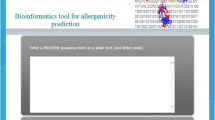Abstract
A structure-activity relationship model for prediction of contact allergenic potential of chemicals had previously been developed. The model had been shown to be able to classify known allergens and non-allergens using data on physicochemical and reactivity parameters of functional groups by discriminant two-value multiple regression analysis. To investigate the model, six selected chemicals which had not been previously investigated for allergenicity were studied with both the model and a murine local lymph-node assay. The same compounds were predicted to be allergens (3-bromo-2-coumaranone, 1-nitrocyclohexene and α-acryloyloxy-β, β-dimethyl-β-butyrolactone) and non-allergens (1-carbethoxy-4-piperidone, 6,7-dimethoxy-2-tetralone and 9-acetylanthracene) by both the model and the local lymph-node assay.
Similar content being viewed by others
References
Magee PS, Hostýnek JJ, Maibach HI (1994) A classification model for allergic contact dermatitis. Quant Struct-Act Relat 13: 22–33
Basketter DA, Roberts DW, Cronin M, Scholes EW (1992) The value of the local lymph node assay in quantitative structure-activity investigations. Contact Dermatitis 2: 137–142
Martin YC, Holland JB, Jarboc CH, Plotnikoff NJ (1974) Discriminant analysis of the relationship between physical properties and the inhibiton of monoamine oxidase by aminotetralins and aminoindans. Med Chem 17: 409–413
Lachenbruch PA (1975) Discriminant analysis. Hafner Press, New York, pp 17–19
Magee PS (1991) Complex factors in hydrocarbon/water, soll/ water and fish/water partitioning. In: Hermens JLM, Opperhulzen A (eds) QSAR in Environmental Toxicology, Elsevier, Amsterdam, pp 155–178
Charton M (1983) Volume and bulk parameters In: Charton M, Motoc I (eds) Steric effects in drug design, chapter 4. Topics in current chemistry 114. Springer, Berlin Heidelberg New York, pp 107–118
Martin YC (1978) Quantitative drug design. Marcel Dekker, New York Basel, pp 377–393
Maurer T, Kimber I (1991) Draining lymph node cell activation in guinea pigs: comparison with the murine local lymph node assay. Toxicology 69: 209–218
Kimber I, Dearman RJ (1991) Investigation of lymph node cell proliferation as a possible immunological correlate of contact sensitizing potential. Fool Chem Toxicol 29: 125–129
Kimber I, Hilton J, Botham PA, Basketter DA, Scholes EW, Miller K, Robbins MC, Harrison PTC, Gray TJB, Waite SJ (1991) The murine local lymph node assay: results of an interlaboratory trial. Toxicol Lett 55: 203–213
Ikarashi Y, Tsukamoto Y, Tsuchiya T, Nakamura A (1993) Influence of irritants on lymph node cell proliferation and the detection of contact sensitivity to metal salts in the murine local lymph node assay, Contact Dermatitis 29: 128–132
Montelius J, Wahlkvist H, Boman A, Fernstrom P, Grabergs L, Wahlberg JE (1994) Experience with the murine local lymph node assay: inability to discriminate between allergens and irritants. Acta Derm Venereol (Stockh) 74: 22–27
Dearman RJ, Basketter DA, Coleman JW, Kimber I (1992) The cellular and molecular basis for divergent allergic responses to chemicals. Chem Biol Interact 84: 1–10
Cumberbatch M, Gould SJ, Peters SW, Basketter DA, Dearman RJ, Kimber I (1992) Influence of topical exposure to chemical allergens on murine Langerhans cells. Comparison of 2,4-dinitrochlorobenzene with trimellitic anhydride. J Clin Lab Immunol 37: 65–81
Author information
Authors and Affiliations
Rights and permissions
About this article
Cite this article
Hostýnek, J.J., Lauerma, A.I., Magee, P.S. et al. A local lymph-node assay validation study of a structure-activity relationship model for contact allergens. Arch Dermatol Res 287, 567–571 (1995). https://doi.org/10.1007/BF00374078
Received:
Issue Date:
DOI: https://doi.org/10.1007/BF00374078




